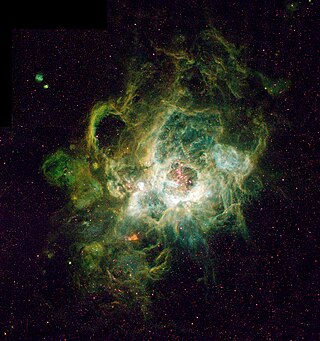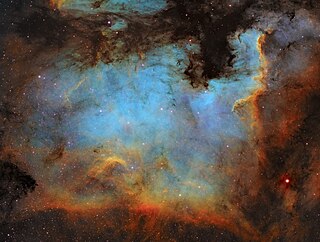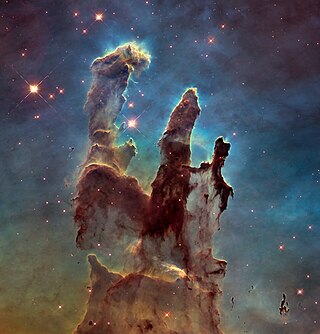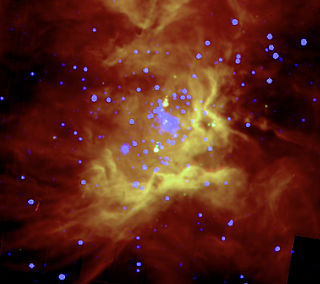
A molecular cloud, sometimes called a stellar nursery (if star formation is occurring within), is a type of interstellar cloud, the density and size of which permit absorption nebulae, the formation of molecules (most commonly molecular hydrogen, H2), and the formation of H II regions. This is in contrast to other areas of the interstellar medium that contain predominantly ionized gas.

Star formation is the process by which dense regions within molecular clouds in interstellar space, sometimes referred to as "stellar nurseries" or "star-forming regions", collapse and form stars. As a branch of astronomy, star formation includes the study of the interstellar medium (ISM) and giant molecular clouds (GMC) as precursors to the star formation process, and the study of protostars and young stellar objects as its immediate products. It is closely related to planet formation, another branch of astronomy. Star formation theory, as well as accounting for the formation of a single star, must also account for the statistics of binary stars and the initial mass function. Most stars do not form in isolation but as part of a group of stars referred as star clusters or stellar associations.

In astronomy, the interstellar medium (ISM) is the matter and radiation that exist in the space between the star systems in a galaxy. This matter includes gas in ionic, atomic, and molecular form, as well as dust and cosmic rays. It fills interstellar space and blends smoothly into the surrounding intergalactic space. The energy that occupies the same volume, in the form of electromagnetic radiation, is the interstellar radiation field. Although the density of atoms in the ISM is usually far below that in the best laboratory vacuums, the mean free path between collisions is short compared to typical interstellar lengths, so on these scales the ISM behaves as a gas (more precisely, as a plasma: it is everywhere at least slightly ionized), responding to pressure forces, and not as a collection of non-interacting particles.

An H II region or HII region is a region of interstellar atomic hydrogen that is ionized. It is typically in a molecular cloud of partially ionized gas in which star formation has recently taken place, with a size ranging from one to hundreds of light years, and density from a few to about a million particles per cubic centimetre. The Orion Nebula, now known to be an H II region, was observed in 1610 by Nicolas-Claude Fabri de Peiresc by telescope, the first such object discovered.

The North America Nebula is an emission nebula in the constellation Cygnus, close to Deneb. It is named because its shape resembles North America.

The Elephant's Trunk Nebula is a concentration of interstellar gas and dust within the much larger ionized gas region IC 1396 located in the constellation Cepheus about 2,400 light years away from Earth. The piece of the nebula shown here is the dark, dense globule IC 1396A; it is commonly called the Elephant's Trunk nebula because of its appearance at visible light wavelengths, where there is a dark patch with a bright, sinuous rim. The bright rim is the surface of the dense cloud that is being illuminated and ionized by a very bright, massive star that is just to the east of IC 1396A. The entire IC 1396 region is ionized by the massive star, except for dense globules that can protect themselves from the star's harsh ultraviolet rays.

The Local Bubble, or Local Cavity, is a relative cavity in the interstellar medium (ISM) of the Orion Arm in the Milky Way. It contains the closest of celestial neighbours and among others, the Local Interstellar Cloud, the neighbouring G-Cloud, the Ursa Major moving group and the Hyades. It is estimated to be at least 1000 light years in size, and is defined by its neutral-hydrogen density of about 0.05 atoms/cm3, or approximately one tenth of the average for the ISM in the Milky Way (0.5 atoms/cm3), and one sixth that of the Local Interstellar Cloud (0.3 atoms/cm3).

Messier 90 is an intermediate spiral galaxy exhibiting a weak inner ring structure about 60 million light-years away in the constellation Virgo. It was discovered by Charles Messier in 1781.

Herbig–Haro (HH) objects are bright patches of nebulosity associated with newborn stars. They are formed when narrow jets of partially ionised gas ejected by stars collide with nearby clouds of gas and dust at several hundred kilometres per second. Herbig–Haro objects are commonly found in star-forming regions, and several are often seen around a single star, aligned with its rotational axis. Most of them lie within about one parsec of the source, although some have been observed several parsecs away. HH objects are transient phenomena that last around a few tens of thousands of years. They can change visibly over timescales of a few years as they move rapidly away from their parent star into the gas clouds of interstellar space. Hubble Space Telescope observations have revealed the complex evolution of HH objects over the period of a few years, as parts of the nebula fade while others brighten as they collide with the clumpy material of the interstellar medium.
An HI region or H I region (read H one) is a cloud in the interstellar medium composed of neutral atomic hydrogen (HI), in addition to the local abundance of helium and other elements. (H is the chemical symbol for hydrogen, and "I" is the Roman numeral. It is customary in astronomy to use the Roman numeral I for neutral atoms, II for singly-ionised—HII is H+ in other sciences—III for doubly-ionised, e.g. OIII is O++, etc.) These regions do not emit detectable visible light (except in spectral lines from elements other than hydrogen) but are observed by the 21-cm (1,420 MHz) region spectral line. This line has a very low transition probability, so it requires large amounts of hydrogen gas for it to be seen. At ionization fronts, where HI regions collide with expanding ionized gas (such as an H II region), the latter glows brighter than it otherwise would. The degree of ionization in an HI region is very small at around 10−4 (i.e. one particle in 10,000). At typical interstellar pressures in galaxies like the Milky Way, HI regions are most stable at temperatures of either below 100 K or above several thousand K; gas between these temperatures heats or cools very quickly to reach one of the stable temperature regimes. Within one of these phases, the gas is usually considered isothermal, except near an expanding H II region. Near an expanding H II region is a dense HI region, separated from the undisturbed HI region by a shock front and from the H II region by an ionization front.
In astronomy, the intracluster medium (ICM) is the superheated plasma that permeates a galaxy cluster. The gas consists mainly of ionized hydrogen and helium and accounts for most of the baryonic material in galaxy clusters. The ICM is heated to temperatures on the order of 10 to 100 megakelvins, emitting strong X-ray radiation.

NGC 2366 is a Magellanic barred irregular dwarf galaxy located in the constellation Camelopardalis.
In astrophysics, photodissociation regions are predominantly neutral regions of the interstellar medium in which far ultraviolet photons strongly influence the gas chemistry and act as the most important source of heat. They occur in any region of interstellar gas that is dense and cold enough to remain neutral, but that has too low a column density to prevent the penetration of far-UV photons from distant, massive stars. A typical and well-studied example is the gas at the boundary of a giant molecular cloud. PDRs are also associated with HII regions, reflection nebulae, active galactic nuclei, and Planetary nebulae. All the atomic gas and most of the molecular gas in the galaxy is found in PDRs.

AB7, also known as SMC WR7, is a binary star in the Small Magellanic Cloud. A Wolf–Rayet star and a supergiant companion of spectral type O orbit in a period of 19.56 days. The system is surrounded by a ring-shaped nebula known as a bubble nebula.

Elephant trunks are a type of interstellar matter formations found in molecular clouds. They are located in the neighborhood of massive O type and B type stars, which, through their intense radiation, can create expanding regions of ionized gas known as H II regions. Elephant trunks resemble massive pillars or columns of gas and dust, but they come in various shapes, lengths, and colors. Astronomers study elephant trunks because of their unique formation process and use 2-D and 3-D simulations to try to understand how this phenomenon occurs.

Westerhout 40 or W40 is a star-forming region in the Milky Way located in the constellation Serpens. In this region, interstellar gas forming a diffuse nebula surrounds a cluster of several hundred new-born stars. The distance to W40 is 436 ± 9 pc, making it one of the closest sites of formation of high-mass O-type and B-type stars. The ionizing radiation from the massive OB stars has created an H II region, which has an hour-glass morphology.

RCW 36 is an emission nebula containing an open cluster in the constellation Vela. This H II region is part of a larger-scale star-forming complex known as the Vela Molecular Ridge (VMR), a collection of molecular clouds in the Milky Way that contain multiple sites of ongoing star-formation activity. The VMR is made up of several distinct clouds, and RCW 36 is embedded in the VMR Cloud C.
Astrophysical fluid dynamics is a branch of modern astronomy which deals with the motion of fluids in outer space using fluid mechanics, such as those that make up the Sun and other stars. The subject covers the fundamentals of fluid mechanics using various equations, such as continuity equations, the Navier–Stokes equations, and Euler's equations of collisional fluids. Some of the applications of astrophysical fluid dynamics include dynamics of stellar systems, accretion disks, astrophysical jets, Newtonian fluids, and the fluid dynamics of galaxies.

Sharpless 2-88 or Sh 2-88 is a region including the diffuse nebula Sh 2-88A and the two compact knots Sh 2-88B1 and Sh 2-88B2, all of which are associated with Vulpecula OB1.

NGC 4522 is an edge-on spiral galaxy located about 60 million light-years away within the Virgo Cluster in the constellation Virgo. NGC 4522 is losing its molecular gas though ram-pressure stripping as it plows though the cluster at a speed of more than 10 million kilometres per hour. The galaxy was discovered by astronomer John Herschel on January 18, 1828.















